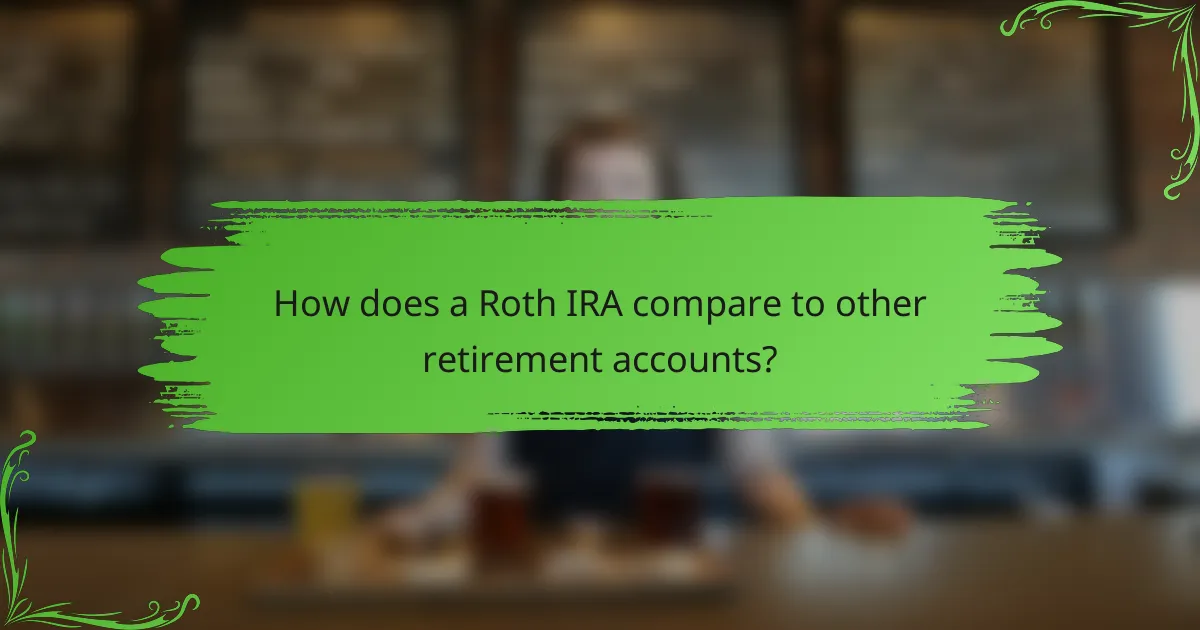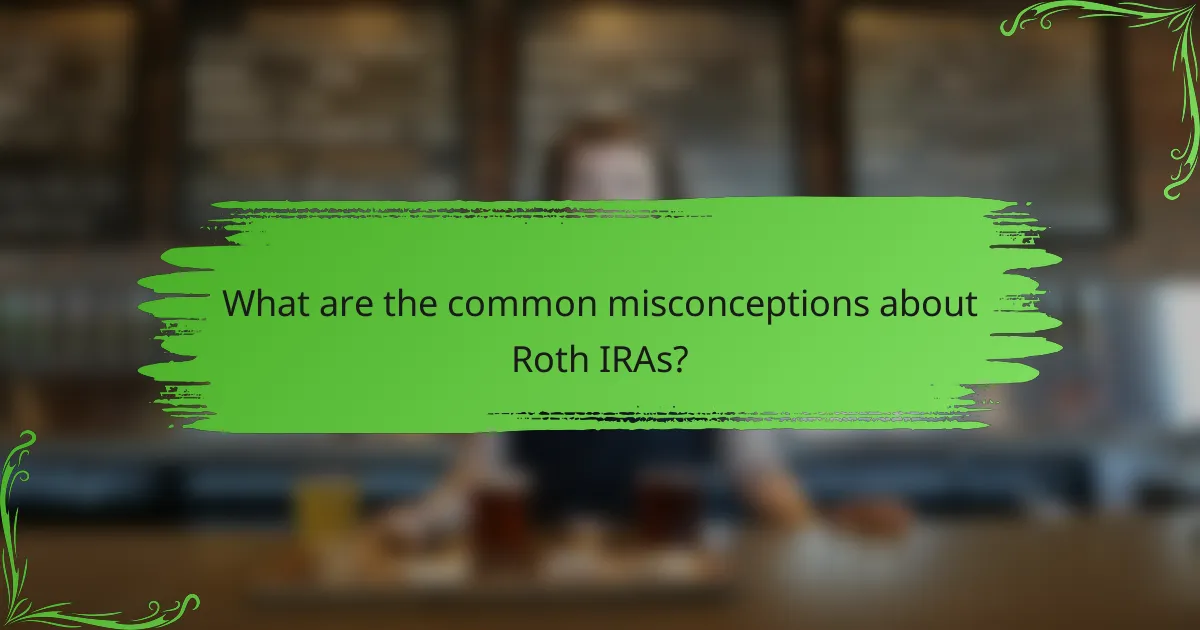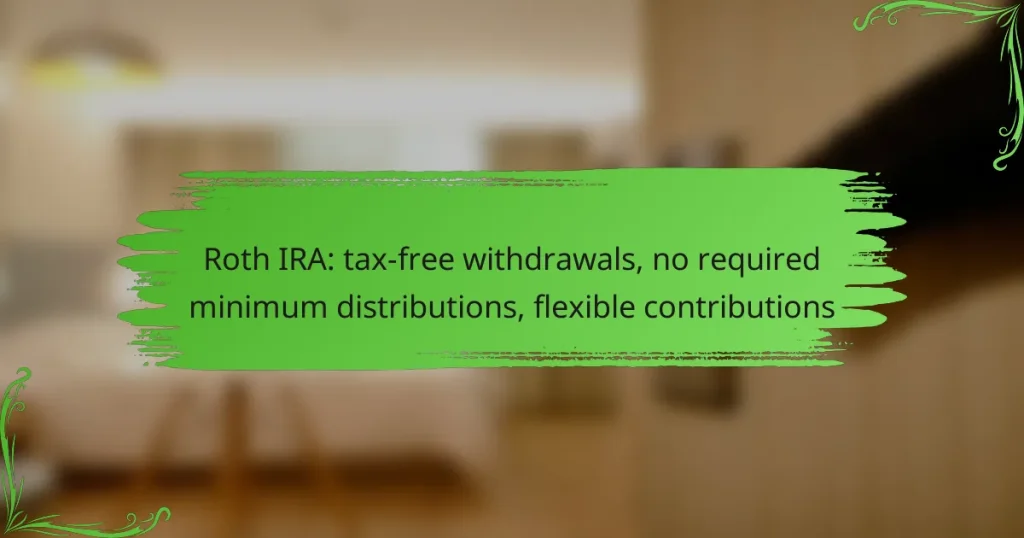A Roth IRA offers a unique advantage with tax-free withdrawals, allowing investors to access their funds without incurring taxes, making it an appealing choice for retirement savings. Additionally, the absence of required minimum distributions provides greater flexibility in managing retirement income, enabling individuals to withdraw funds on their own terms. With flexible contribution options, investors can tailor their savings strategy to fit their financial situation throughout the year, as long as they adhere to annual limits and income requirements.

How can Roth IRA tax-free withdrawals benefit UK investors?
Roth IRA tax-free withdrawals offer UK investors a unique opportunity to access their funds without incurring taxes, making it an attractive retirement savings option. This feature, combined with the absence of required minimum distributions, allows for greater flexibility in managing retirement income.
No taxes on qualified distributions
Qualified distributions from a Roth IRA are completely tax-free, provided certain conditions are met. To qualify, the account must be held for at least five years, and the withdrawal must occur after the account holder reaches age 59½ or due to disability or death. This means UK investors can enjoy their retirement savings without worrying about additional tax liabilities.
For example, if a UK investor withdraws £20,000 from their Roth IRA after meeting the requirements, they will receive the full amount without any tax deductions. This contrasts with traditional retirement accounts, where withdrawals are typically taxed as income.
Access to funds without penalties
Roth IRAs allow investors to access their contributions at any time without incurring penalties. This feature provides a safety net for unexpected expenses or emergencies, as investors can withdraw their original contributions without tax or penalty. However, it’s essential to distinguish between contributions and earnings, as withdrawing earnings before meeting the qualified distribution criteria may result in penalties.
For instance, if a UK investor contributed £30,000 to their Roth IRA, they can withdraw that amount at any time without penalties. However, if they attempt to withdraw any earnings before age 59½ and without meeting the five-year rule, they could face a 10% penalty on those earnings.
Tax-free growth on investments
Investments within a Roth IRA grow tax-free, meaning that any capital gains, dividends, or interest earned are not subject to taxation. This tax-free growth can significantly enhance the overall value of the retirement account over time. For UK investors, this means that the money can compound without the drag of taxes, potentially leading to a larger nest egg for retirement.
For example, if an investor contributes £5,000 annually to a Roth IRA and achieves an average annual return of 7%, the account could grow substantially over several decades. By the time they retire, the tax-free growth could result in a significantly higher amount compared to a taxable account.

What are the flexible contribution options for a Roth IRA?
Roth IRAs offer flexible contribution options that allow individuals to tailor their retirement savings to their financial situation. You can contribute to a Roth IRA at any time during the year, as long as you stay within the annual limits and meet income requirements.
Annual contribution limits
The annual contribution limit for a Roth IRA is set by the IRS and typically adjusts each year for inflation. For individuals under 50, the limit is generally in the low thousands of USD, while those 50 and older can contribute more due to catch-up provisions.
For example, in recent years, the contribution limit has been around $6,000 for younger investors and $7,000 for those aged 50 and above. It’s essential to check the current limits each tax year to ensure compliance.
Catch-up contributions for older investors
Catch-up contributions allow individuals aged 50 and older to save more for retirement by exceeding the standard contribution limits. This provision is particularly beneficial for those who may have started saving later in life.
Older investors can contribute an additional amount, often around $1,000, to their Roth IRA, which can significantly boost their retirement savings. This option is a valuable tool for enhancing financial security in retirement.
Contribution phase-out limits
Roth IRA contributions are subject to income phase-out limits, meaning that higher earners may not be eligible to contribute directly. These limits vary based on tax filing status, typically affecting individuals with modified adjusted gross incomes above a certain threshold.
For instance, single filers may see phase-out limits starting in the mid-hundreds of thousands of USD, while married couples filing jointly have higher thresholds. If your income exceeds these limits, consider alternative strategies, such as a backdoor Roth IRA, to still benefit from tax-free growth.

What are the advantages of no required minimum distributions?
No required minimum distributions (RMDs) allow Roth IRA account holders to withdraw funds on their own terms, providing significant flexibility in retirement planning. This feature enables individuals to manage their withdrawals without being forced to take distributions at a certain age, which can help in tax planning and maintaining control over their investments.
Maintain control over retirement funds
The absence of RMDs means that Roth IRA holders can decide when and how much to withdraw from their accounts. This control allows for better management of retirement savings, as individuals can choose to let their investments grow for a longer period without being pressured to take distributions. For example, if market conditions are favorable, one might opt to delay withdrawals to maximize growth.
Additionally, maintaining control over funds can help retirees avoid unnecessary tax liabilities that might arise from forced withdrawals. By strategically planning withdrawals, individuals can minimize their taxable income and potentially stay in a lower tax bracket.
Potential for increased tax-free growth
Without the requirement to take distributions, Roth IRA funds can continue to grow tax-free for an extended period. This feature is particularly advantageous for those who do not need immediate access to their retirement savings. The longer the money remains in the account, the more it can compound, leading to potentially higher tax-free withdrawals in the future.
For instance, if a retiree allows their Roth IRA to grow for several years without withdrawals, they may benefit from significant growth, especially if invested in higher-yield assets. This strategy can be particularly effective for younger retirees or those with other income sources.
Flexibility in withdrawal timing
The lack of RMDs provides Roth IRA holders with the flexibility to withdraw funds when it best suits their financial situation. This can be particularly useful for managing unexpected expenses or adjusting to changes in lifestyle. For example, if a retiree faces a medical emergency, they can choose to withdraw funds without the constraints of mandatory distributions.
Moreover, this flexibility allows individuals to plan their withdrawals in a way that aligns with their overall financial strategy, whether that means taking larger distributions in years with lower income or delaying withdrawals to maximize tax benefits. This adaptability can lead to more effective retirement income management.

What factors should UK investors consider before opening a Roth IRA?
UK investors should consider their eligibility based on income, the types of investments available, and the potential tax implications before opening a Roth IRA. Understanding these factors can help maximize the benefits of this retirement account.
Eligibility based on income
To contribute to a Roth IRA, investors must meet certain income thresholds. For 2023, individuals with a modified adjusted gross income (MAGI) below approximately $138,000 can contribute the full amount, while those earning between $138,000 and $153,000 may be eligible for reduced contributions. Couples filing jointly have a higher threshold, with full contributions allowed for MAGI under about $218,000.
It’s crucial to note that if your income exceeds these limits, you may not be able to contribute directly to a Roth IRA. However, a backdoor Roth IRA strategy can be an alternative, allowing high earners to convert traditional IRA funds to a Roth IRA.
Investment options available
A Roth IRA offers a wide range of investment options, including stocks, bonds, mutual funds, and exchange-traded funds (ETFs). This flexibility allows investors to tailor their portfolios according to their risk tolerance and retirement goals. Many providers offer various investment vehicles, so it’s essential to compare options to find one that aligns with your strategy.
Additionally, consider the fees associated with different investment options. Low-cost index funds or ETFs may be preferable for cost-conscious investors, while actively managed funds might appeal to those seeking potentially higher returns. Evaluating both performance and expenses can significantly impact your long-term growth in a Roth IRA.

How does a Roth IRA compare to other retirement accounts?
A Roth IRA offers unique advantages over other retirement accounts, particularly in terms of tax treatment and withdrawal flexibility. Unlike traditional IRAs and 401(k) plans, Roth IRAs allow for tax-free withdrawals and do not impose required minimum distributions (RMDs), making them an attractive option for many savers.
Comparison with traditional IRA
The primary difference between a Roth IRA and a traditional IRA lies in how and when taxes are paid. Contributions to a traditional IRA are typically tax-deductible, but withdrawals during retirement are taxed as ordinary income. In contrast, Roth IRA contributions are made with after-tax dollars, allowing for tax-free withdrawals in retirement.
Another key aspect is the required minimum distributions. Traditional IRAs mandate RMDs starting at age 73, which can lead to unexpected tax liabilities. Roth IRAs do not have RMDs during the account holder’s lifetime, providing more control over retirement funds.
Comparison with 401(k) plans
When comparing Roth IRAs to 401(k) plans, the tax treatment again stands out. Contributions to a traditional 401(k) are made pre-tax, reducing taxable income in the contribution year, while Roth 401(k) contributions are made after taxes, similar to a Roth IRA. This means that withdrawals from a Roth 401(k) are also tax-free, but they are subject to RMDs, unlike Roth IRAs.
Contribution limits are another consideration. For 2023, individuals can contribute up to $6,500 to a Roth IRA, or $7,500 if they are age 50 or older. In contrast, 401(k) plans allow for higher contributions, up to $22,500, or $30,000 for those aged 50 and above. This makes 401(k) plans a better option for those looking to save larger amounts for retirement, while Roth IRAs provide tax-free growth and withdrawal benefits.

What are the common misconceptions about Roth IRAs?
Many people misunderstand Roth IRAs, believing they are only for high-income earners or that withdrawals are always taxable. In reality, Roth IRAs offer tax-free withdrawals for qualified distributions and have no required minimum distributions during the account holder’s lifetime, making them a flexible retirement savings option.
Roth IRAs are only for high-income earners
A common misconception is that only individuals with high incomes can contribute to a Roth IRA. While there are income limits for contributions, many people still qualify. For 2023, single filers can contribute if their modified adjusted gross income (MAGI) is below $138,000, while married couples filing jointly can contribute if their MAGI is below $218,000.
Even if your income exceeds these thresholds, you may still be able to use a backdoor Roth IRA strategy, which involves contributing to a traditional IRA and then converting it to a Roth IRA. This method allows higher earners to take advantage of the benefits of a Roth IRA.
Withdrawals from a Roth IRA are always taxable
Another misconception is that all withdrawals from a Roth IRA are subject to taxes. In fact, qualified withdrawals, which include contributions and earnings taken after age 59½ and after the account has been open for at least five years, are tax-free. This makes Roth IRAs particularly attractive for retirement planning.
However, if you withdraw earnings before meeting these conditions, you may face taxes and penalties. It’s essential to understand the rules surrounding withdrawals to maximize the tax benefits of your Roth IRA.
Roth IRAs have required minimum distributions (RMDs)
Many believe that Roth IRAs require account holders to take minimum distributions during their lifetime, similar to traditional IRAs. This is not the case. Roth IRAs do not have required minimum distributions, allowing your investments to grow tax-free for as long as you want.
This feature makes Roth IRAs an excellent option for those who wish to leave their savings untouched for a longer period or for estate planning purposes. You can choose to withdraw funds when it best suits your financial needs without the pressure of RMDs.
Contributions to a Roth IRA are inflexible
Some people think that contributions to a Roth IRA are rigid and cannot be adjusted. In reality, Roth IRAs offer flexible contribution options. You can contribute up to $6,500 per year (or $7,500 if you are age 50 or older) as of 2023, and you can adjust your contributions based on your financial situation.
Additionally, you can withdraw your contributions at any time without penalties or taxes, providing a level of accessibility that many other retirement accounts do not offer. This flexibility can be beneficial for managing unexpected expenses while still saving for retirement.


